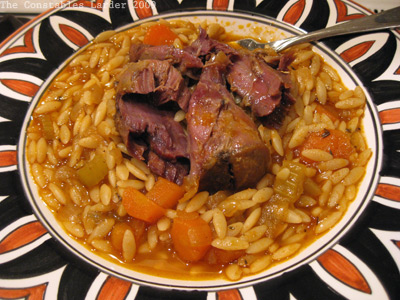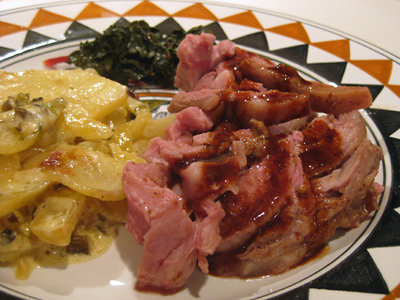One thing I love about cooking is the freedom to embrace influences and the cumulative lessons of history. As a cook, one can learn from a rich body of experience built up within and across cultures, while preserving one’s own sense of self and style. In other words, derivative doesn’t have to be a bad word when it comes to cooking. The global synthesis of culinary ideas is celebrated.
This freedom is more fleeting in art, where there is a stronger fear of being derivative, partially driven by an art economy that places “new” on a pedestal. In food there is certainly a celebration of innovation, hence the fame of E Bulli and Alinea, but perhaps because cooking is as physical as it is mental, there is a greater acceptance, even glorification, of tradition and the merger of past and present. The physical also provides boundaries for how far things can be stretched. If something tastes bad, no amount of curatorial exposition can explain it into a good experience (though no doubt, some try).
So why the long introduction? Well, this recipe was triggered because I dropped by a lovely Greek food blog, Kali Orexi, and saw Maria’s chicken baked with orzo. Stopped the mental presses. Slammed on the browser brakes. I knew one thing at that moment: I had to bake the lamb shanks lurking in my fridge with orzo.
Then I spent an enjoyable part of this morning researching lamb shank cooking techniques in order to synthesize my own dish. I traversed numerous cookbooks (Child, Boulud, Tanis, Brown, etc) and many websites/blogs (Epicurious, Cookstr, Simply Recipes, Wednesday Chef, etc), and got some good ideas and discovered some cool things for future recipes.
The end results of this particular meal were fabulous. I do not always love lamb, but the flavor combinations were great, and I was also working with very young lamb carried by Fleishers, my favorite butcher. After flubbing a dinner on Friday night (I managed to create a tasteless pork chop brine, it seems… yes, the talent!), it was quite a relief to believe that I can cook after all! When an Aussie tells you that you did a good job with lamb, I think that means you can feel a sense of accomplishment, even if she is your wife (or should that be, especially?!).

Braised Lamb Shanks with Orzo
Serves two or three
2 lamb shanks (approx 1 lb each)
1 large vidalia or spanish onion, chopped
3 medium carrots, peeled and chopped
1 celery stalk, chopped
1 1/2 tbsp tomato paste
3 garlic cloves, peeled
4 stalks of parsley
1/2 cup of dry vermouth
1 to 2 cups of chicken broth
2 pinches of ground savory
2 pinches of ground sage
2 pinches of dried thyme (or a few stalks of fresh thyme)
1 bay leaf
salt and pepper
1 cup orzo
For prep, preheat oven to 300F and heat up your chicken broth in a saucepan or microwave.
Lightly salt the shanks. On a high flame, heat up a healthy splash of olive oil in a dutch oven large enough to fit the lamb shanks, and brown all sides of the lamb shanks, then remove the shanks to the side. Immediately lower the heat to medium-low and place the onions in the pot, stirring for a few minutes, and then add the carrots and celery. Cook for several minutes and add in the tomato paste, and cook for several more minutes.
Deglaze the bottom of the pan with the vermouth, and then place the shanks back in the pot. Add in enough chicken broth to reach about halfway up the shanks. Add in the garlic, herbs, bay leaf, and 1/4 tsp coarse salt.
Cover and place in the oven. Braise for 2 to 2 1/2 hours, turning the meat every hour.
Near the end of the braising period, bring a large pot of water to boil. You will use this to partially cook the orzo before adding the pasta to the dutch oven.
Remove the dutch oven from the oven, and remove the shanks to a side plate. Discard the garlic cloves. Spoon out the fat/oil from the surface of the liquid (this is the most painstaking part of this entire recipe). While you are doing this, boil the orzo for no more than 5 or 6 minutes in your pot of boiling water. Reserve about 1/2 cup of the starchy water (although if there is very little liquid left in your dutch oven, you might reserve a bit more), and drain the orzo.
At this point, you should have skimmed as much oil as you can from the top of the liquid and vegetables in the dutch oven. Stir in the 1/2 cup of orzo-cooking water, and then stir in the orzo itself. Place the shanks back on top, and return to the oven, uncovered, for 15 more minutes.
Finally, remove the shanks to the side, remove the meat from the bones and gristle, and sprinkle with a little salt. Taste the orzo and vegetables for salt and pepper (I found that this dish wanted a lot of ground pepper, but do so to your taste). Serve the lamb on a bed of the orzo mixture.
This dish pairs nicely with a relatively full-bodied red wine, such as a strong zinfindel but a shiraz or cabernet sauvingon would also be nice.


